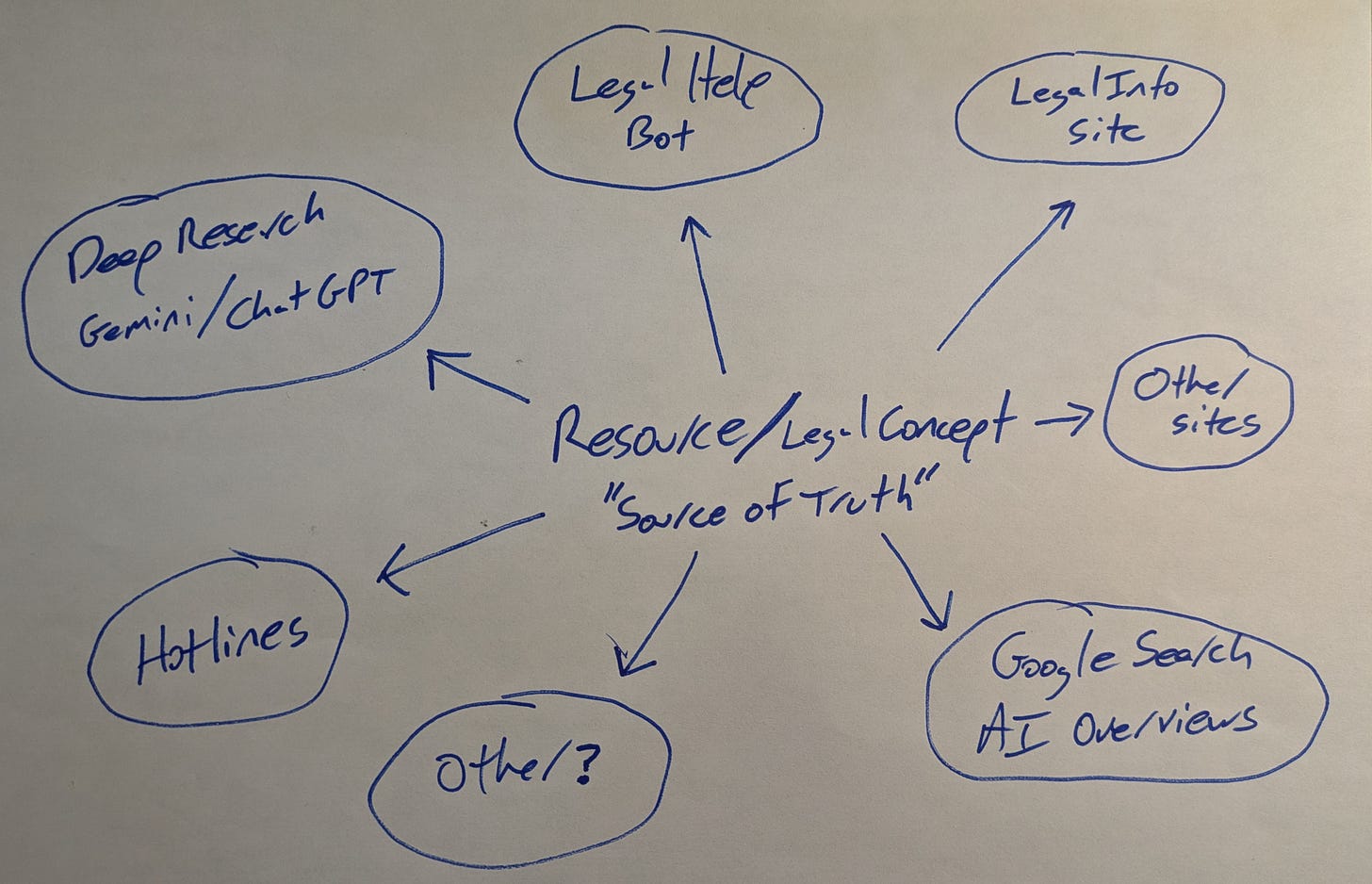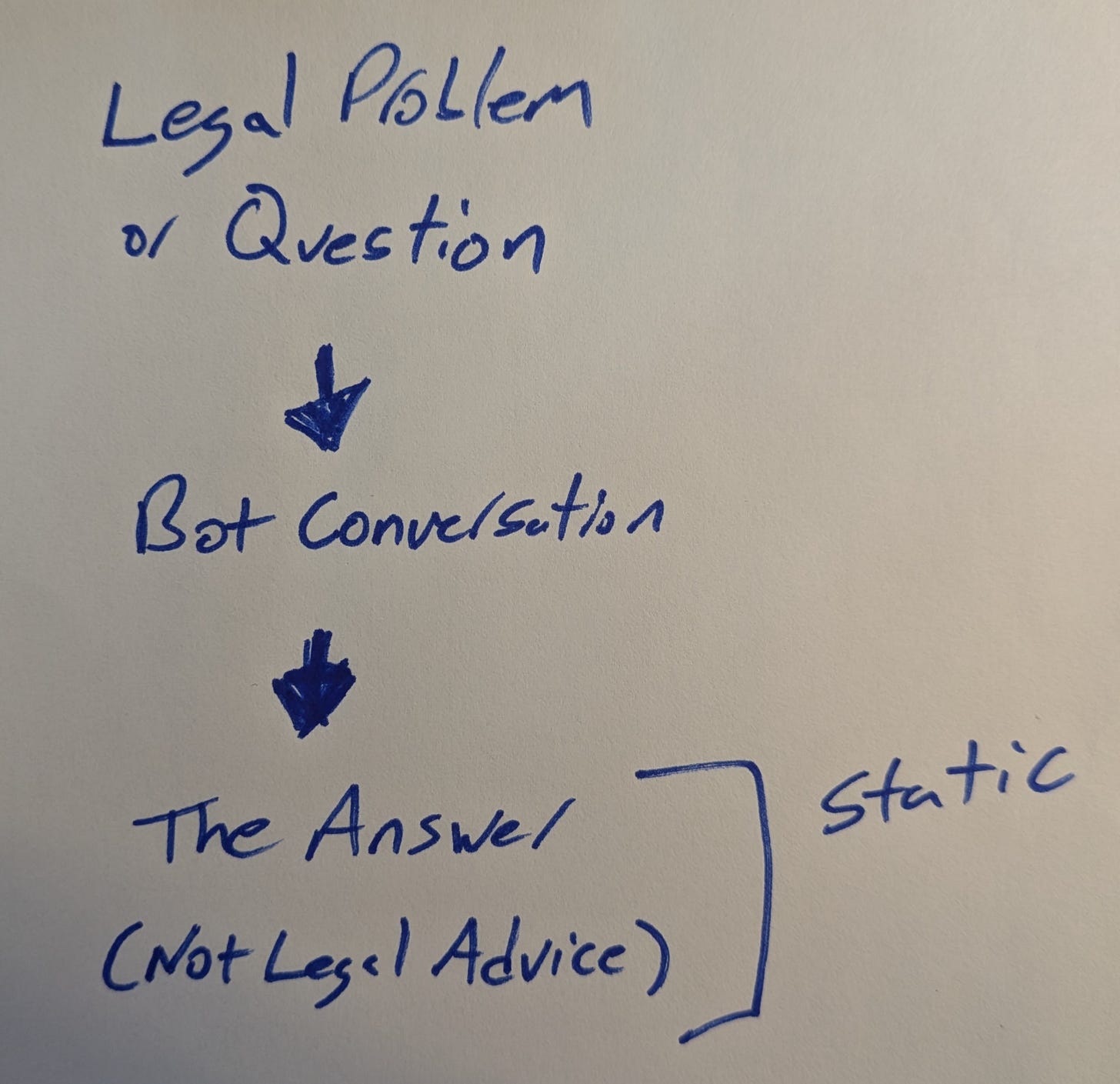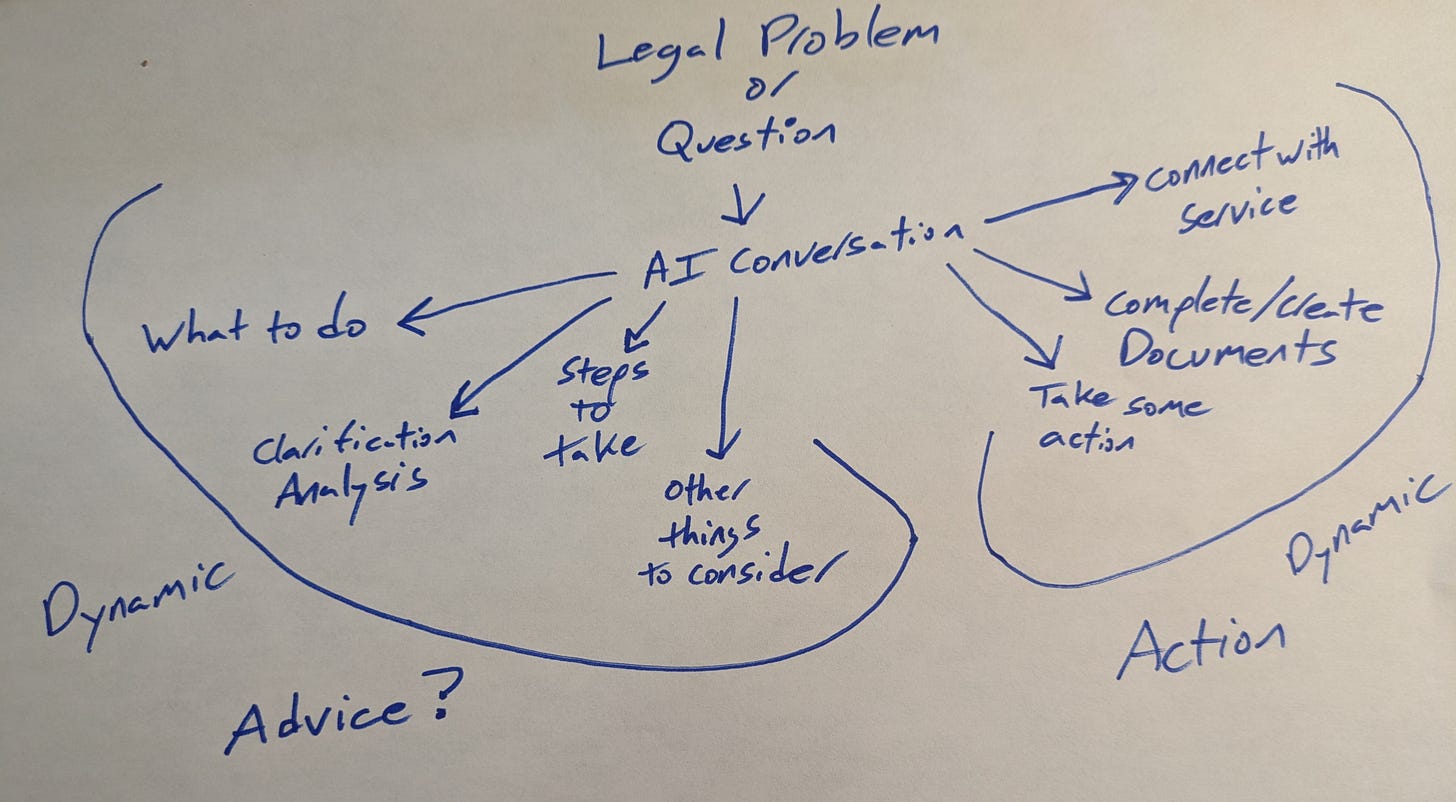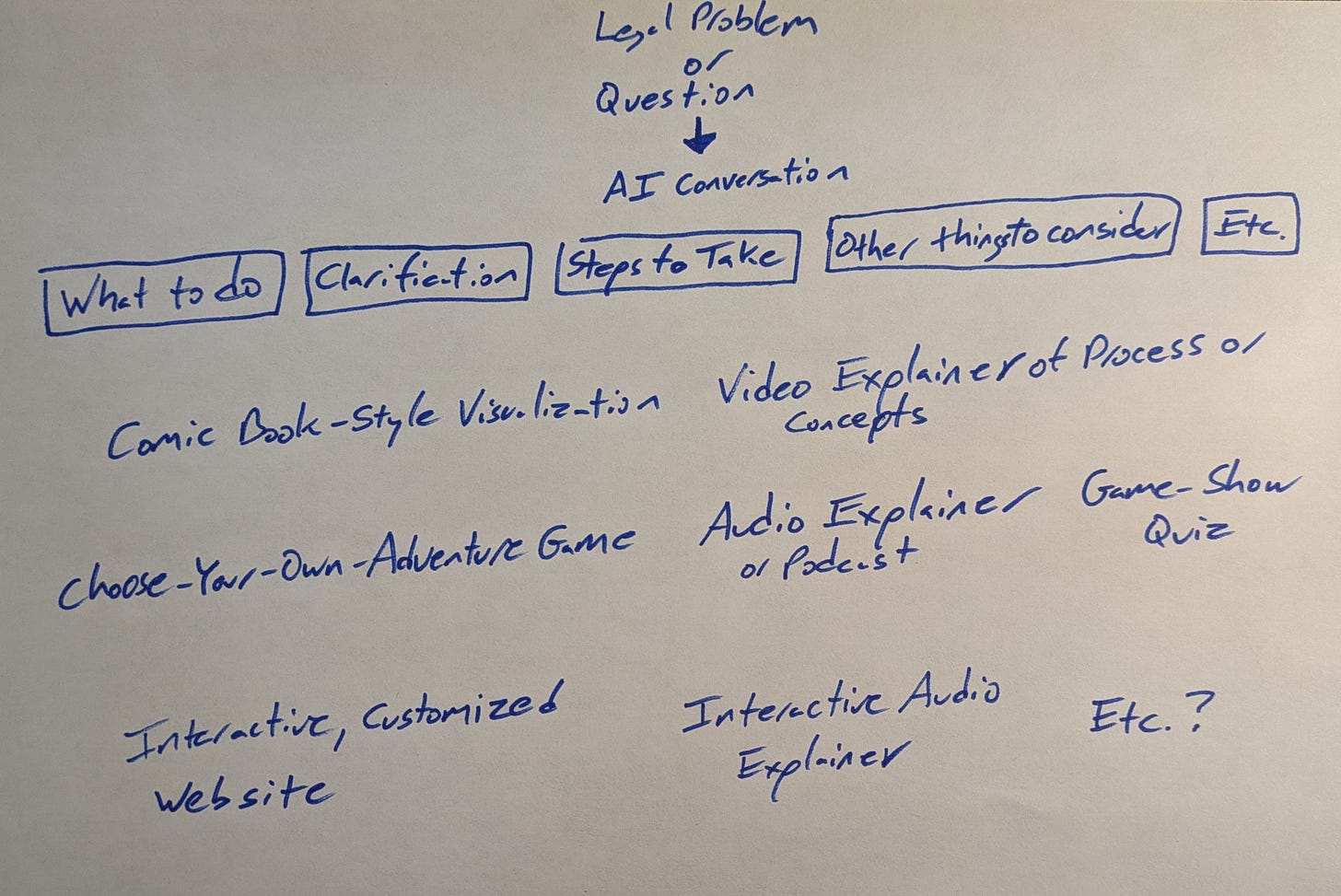Last week I wrote a post about the “unknown middle” - essentially the concept of innovating in the middle between vibe-coding and enterprise-grade software. On the same theme, I want to talk at to you about how people on the internet are getting legal help, and how is AI changing that?
Currently:
When we in Legal Aid / Legal Non-Profit Tech Land have traditionally thought about giving people legal information while online, we generally ended up conceiving of a process that looks kind of like this funnel:
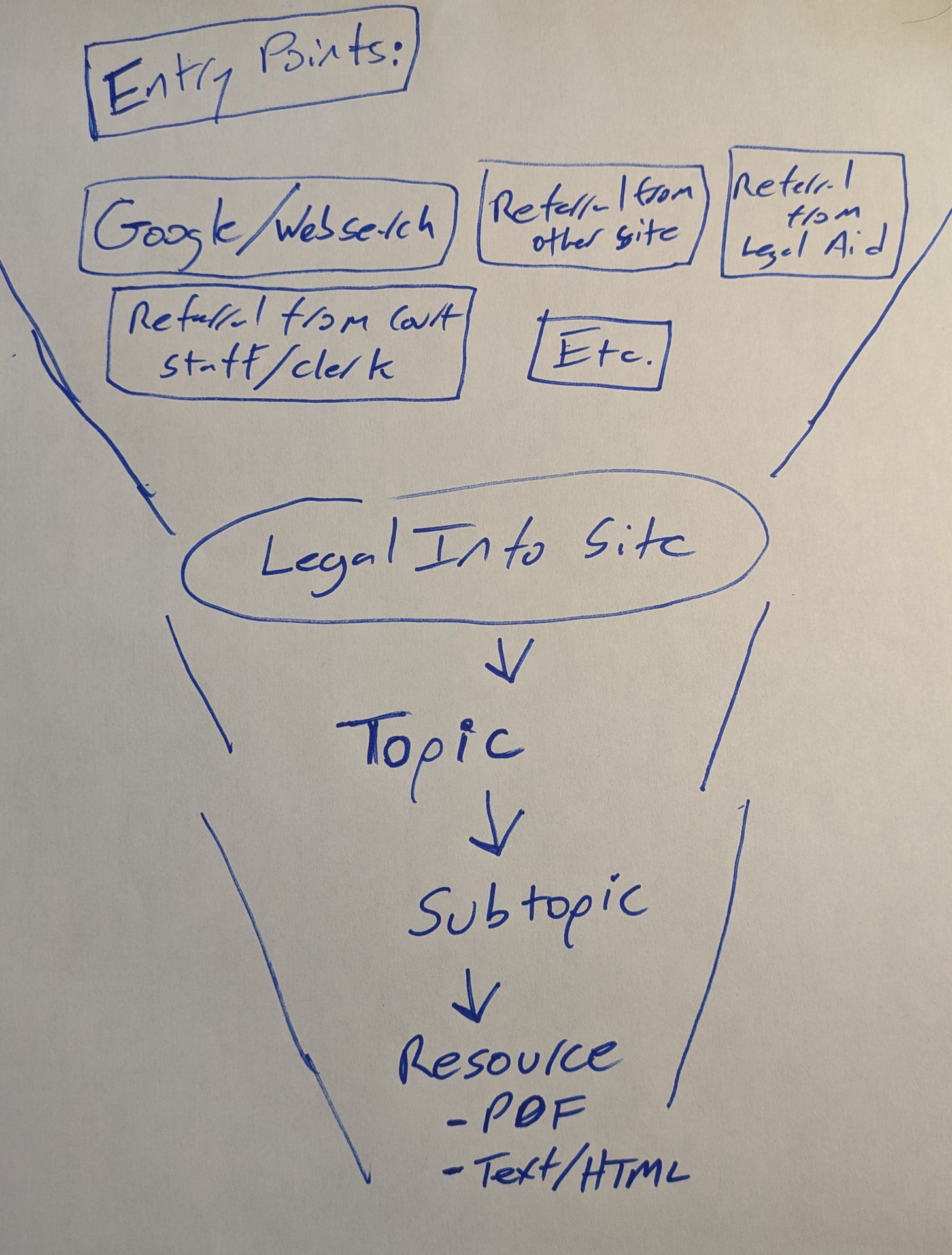
Hopefully you can read my handwriting there, but essentially the goal of online legal help systems is to funnel people from different entry points down to one page, or one PDF. A person going through a divorce and who had a question about what will happen at their upcoming court hearing (assuming they couldn’t afford a lawyer ) would:
Go to Google and search for “divorce”
Ignore the 5,000 lawyer pay-per-click ads
See their state’s LawHelp site, click on it
On the LawHelp site home page, click on a tile that says “family law”
On the “family law” page, click on the tile that says “divorce”
Find a resource (really a webpage or a link to download a PDF) that talks about what happens at a court hearing.
Read the resource.
That’s the funnel concept. There are many ways into the funnel - Google, a link from another site, a referral from a court clerk, a referral from a hotline operator, etc. This is traditionally called the “no wrong door” approach. The point of this type of system is to push people into the funnel and have them get the information from a specific place. It’s kind of like there being only one cookbook at the library, and if you ask any one about how to cook something, you’ll end up on the way to find that book and have to look up the recipe you want to cook.
But information doesn’t exactly work that way. In reality, there are thousands of sources of legal information out there, all updated on different schedules, some up-to-date and some not, some helpful and some not, and all accessible through different winding and intersecting pathways.
So maybe if we think about our resource not as a finite thing, like words on a PDF or in HTML, but as a concept, a “source of truth” about a legal idea or process, things become a bit more natural. Instead of a funnel whose goal is to get as many people clicking on the same link as possible, the goal would be to get the information to as many people as possible through as many mediums as possible:
This is what has struck me the most about Google putting the AI Overviews front-and-center in their search experience. Legal help resources are built for the world that existed before, not the world we have now. If what we’re interested in, really, is measuring how many people downloaded a PDF and calling that success, then that would be fine. But that’s not really how things work now. Maybe we should be interested in making the information as accessible as possible, and in my mind that means allowing that information to be digested and regurgitated by things like ChatGPT or Gemini, or chatbots, etc.
FunnelBot:
One thing that’s interesting is that, while a lot of people are building chatbots, they still follow the funnel method, at least conceptually:
The goal of a lot of legal chatbots is to route people to The Answer, which can sometimes be a link to a PDF. It’s static - The Answer has not changed with or adapted to the user’s input or individual circumstances. The Answer is, most definitely, not legal advice - mainly because it is static, not dynamic. For example, our user’s question about what will happen at their upcoming family court hearing will be answered with something like a reference to an article titled “What Happens at a Typical Court Proceeding in Family Court.” Helpful in some ways, but not dynamic.
But we could think more along the lines of something like this:
Instead of a link to a PDF or a webpage, a user could have a conversation with an AI that does things like:
Explains what to do in their situation;
Clarifies or helps them analyze their legal problem;
Tells them recommended steps to take; and
Tells them other things they should be considering.
All these things can be dynamic - they’re adapted to the user’s actual situation, as sussed out through a back-and-forth conversation. In the image, I’m putting this on the “Advice?” end of the spectrum, because maybe this is advice, and not just information.
But there’s other things such a system could do as well. Agentic systems are capable of not just giving advice (“here’s what you should do”), they’re also capable of acting on the user’s behalf (“can I do that for you”). So this type of system could:
connect the user with a organization or service;
fill out paper work or court documents; and
make phone calls and set up appointments.
Let’s table the agentic aspect for now, as interesting as it is, and think more about the advice(?) aspect.
MultiBot:
Maybe we can take this advice concept a bit further. When we think of the “here’s some advice” aspect, we’re probably thinking about advice in terms of words on a (web)page, or a chat dialog. But AI lets us expand the surface area of what we can do dramatically. We could have true multi-modal legal advice, all for a negligible amount of compute:
So instead of a chat, we could have a system that creates:
a comic-book style visualization of the next steps the user needs to take1;
video explainers of court processes or legal concepts;
a choose-your-own-adventure game that teaches the user about potential consequences and upsides to certain choices or legal options;
an audio podcast that explains their case, and what they can and should do;
a game show-style quiz that reinforces important court procedures or legal concepts to understand;
an interactive, customized web application that explains important concepts;
an interactive audio experience where a user can ask questions and have them answered (like Google’s NotebookLM);
other things I’m not thinking of.
5 years ago this would have all sounded far-fetched. Right now all of this is doable. Now. I’ve even provided links to some examples.
Instead of the funnel concept we could have something much more potent - an ecosystem that gives legal advice, in different ways, all adapted to the learning needs of the user. Imagine this - our person going through a divorce can, with a few lines of dialog or clicks, create their own legal help ecosystem that’s multi-modal, and fully customized for them and their situation. The pieces are all there, available, and kind of spread across different systems, but they’re there. This is what I keep coming back to when I think about “the middle” and where innovation can happen.
An example of comic book-style visualizations can be found in this paper: https://drive.google.com/file/d/1aAwISZf0yHz8C-vHtGvTKYNvRNQDnsTo/view?usp=sharing



